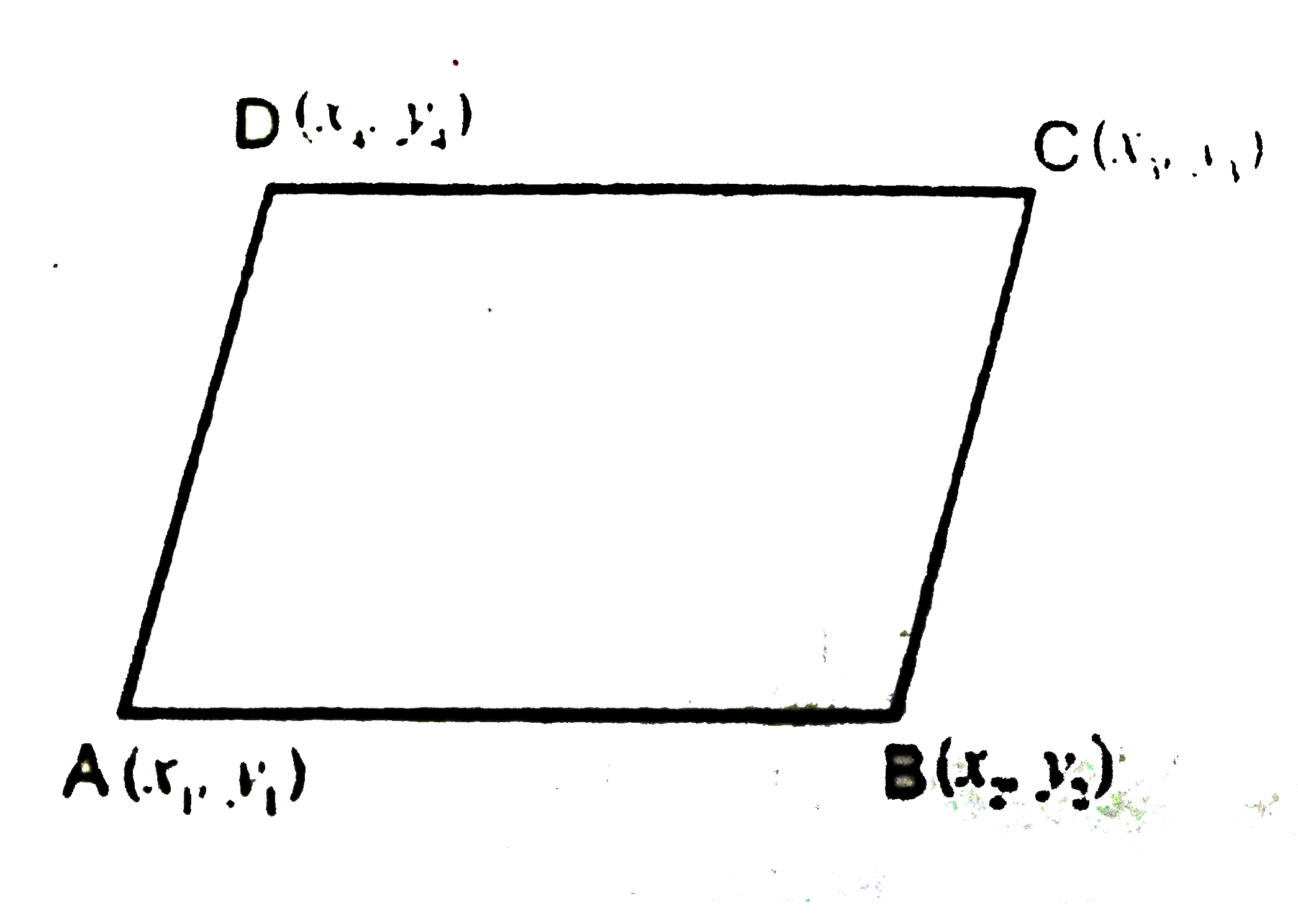यदि बिन्दुए (x1,y1),(x2,y2),(x3,y3) एक समानान्तर चतुर्भुज के तीन क्रमागत शीर्ष है , जो चौथे शीर्ष के निर्दशाक ज्ञात करे |
मान कि A≡(x1,y1),B≡(x2,y2) और C≡(x3,y3)
माना कि D≡(x4,x4)
माना कि L और M क्रमश: AD और BD के मध्य बिन्दु है
तो L≡(x1+x32,y1+y22)
और M≡(x2+x42,y2+y42)
चुकीं ABCD एक समीकरण चतुर्भुज है | अत : AC और BD एक - दूसरी को समिद्विभागा करेंगे |
अतः L और M एक कि बिन्दु है |

Topper's Solved these Questions
- निर्देशांक ज्यामिति Book:KC SINHAChapter:निर्देशांक ज्यामिति Exercise:प्रश्नावली 7.1 (अतिलघु उत्तरीय प्रश्न )
Explore 13 Videos
- निर्देशांक ज्यामिति Book:KC SINHAChapter:निर्देशांक ज्यामिति Exercise:प्रश्नावली 7.1 (लघु उत्तरीय प्रश्न )
Explore 5 Videos
- द्विघात समीकरण Book:KC SINHAChapter:द्विघात समीकरण Exercise:वस्तुनिष्ट प्रशन
Explore 37 Videos
- पृष्ठीय क्षेत्रफल और आयतन Book:KC SINHAChapter:पृष्ठीय क्षेत्रफल और आयतन Exercise:वस्तुनिष्ट प्रश्न(Objective Questions)
Explore 30 Videos
Similar Questions
निम्नलिखित बिन्दुए किस चतुर्थेाश में स्थित है |
(10,−3)
View Solutionयदि किसी आयत के तीन शीर्ष (−2,0),(2,0),(2,1) है तो चौथे शीर्ष के नियामक ज्ञात कीजिए |
View Solutionयदि a और b समीकरण x2−ax+b=0 के मूल है तब
View Solutionएक खोखला धातुई गोला जिसकी बाह्य त्रिज्या 6cm और अन्तः त्रिज्या 4cm है को पिघलाया जाता है और इसे एक शंकु जिसके आधार की त्रिज्या 6cm है, के रूप में ढाला जाता है, तो शंकु की ऊँचाई है:
View SolutionThe value of |2x1y1x1y2+x2y1x1y3+x3y1x1y2+x2y12x2y2x2y3+x3y2x1y3+x3y1x2y3+x3y22x3y3| is.
View SolutionIf the points (x1,y1),(x2,y2), and (x3,y3) are collinear show that y2−y3x2x3+y3−y1x3x1+y1−y2x1x2=0
View SolutionIf the join of (x1,y1) and (x2,y2) makes on obtuse angle at (x3,y3), then prove than (x3−x1)(x3−x2)+(y3−y1)(y3−y2)<0
View SolutionIf the normal at the point P(x_(i),y_(i)),i=1,2,3,4 on the hyperbola xy=c^(2) are concurrent at the point Q(h,k) then _((x_(1)+x_(2)+x_(3)+x_(4))(y_(1)+y_(2)+y_(3)+y_(4)))((x_(1)+x_(2)+x_(3)+x_(4))(y_(1)+y_(2)+y_(3)+y_(4)))/(x_(1)x_(2)x_(3)x_(4)) is
View SolutionIf (x_(1),y_(1)),(x_(2),y_(2)),(x_(3),y_(3)) are vertices of equilateral triangle such that (x_(1)-2)^(2)+(y_(1)-3)^(2)=(x_(2)-2)^(2)+(y_(2)-3)^(2)=(x_(3)-2)^(2)+(y_(3)-3)^(2) then
View Solutionif (x_ (1), y_ (1)), (x_ (2), y_ (2)), (x_ (3), y_ (3)) are vertices equilateral triangle such that (x_ (1) -2) ^ (2) + (y_ (1) -3) ^ (2) = (x_ (2) -2) ^ (2) + (y_ (2) -3) ^ (2) = (x_ (3) - 2) ^ (2) + (y_ (3) -3) ^ (2) then x_ (1) + x_ (2) + x_ (3) +2 (y_ (1) + y_ (2) + y_ (3) ))
View SolutionA triangle has vertices Ai(xi,yi) for i= 1,2,3,. If the orthocenter of triangle is (0,0) then prove that
∣∣ ∣ ∣∣x2−x3y2−y3y1(y2−y3)+x1(x2−x3)x3−x1y3−y1y2(y3−y1)+x2(x3−x1)x1−x2y1−y2y3(y1−y2)+x3(x1−x2)∣∣ ∣ ∣∣=0
View SolutionIf (x1,x2)2+(y1−y2)2=a2,(x2−x3)2+(y2−y3)2=b2(x3−x1)2+(y3−y1)2=c2. where a,b,c are positive then prove that 4∣∣ ∣ ∣∣x1y11x2y21x3y31∣∣ ∣ ∣∣=(a+b+c)(b+c−a)<br>(c+a−b)(a+b−c)
View Solutionअगर बिन्दुएं (x1,y2),(x2,y2) और (x3,y3) संरेखी है तब दिखायें कि y2−y3x2x3+y3,y2x3y1+y1−y2x1x2=0
View SolutionIf (x1,y1),(x2,y2),(x3,y3)and(x4,y4) be the consecutive vertices of a parallelogram , show that , x1+x3=x2+x4andy1+y3=y2+y4.
View SolutionIf (x1−x2)2+(y1−y2)2=a2,(x2−x3)2+(y2−y3)2=b2,(x3−x1)2(y3−y1)2=c2 and ∣∣ ∣ ∣∣x1y11x2y21x3y31∣∣ ∣ ∣∣2=(a+b+c)(b+c−a)(c+a−b)(a+b−c) then the value of λ is:
View SolutionIf x1,x2,x3 are in A.P. and y1,y2,y3 are in A.P. then the points (x1,y1),(x2,y2),(x3,y3)
View Solution